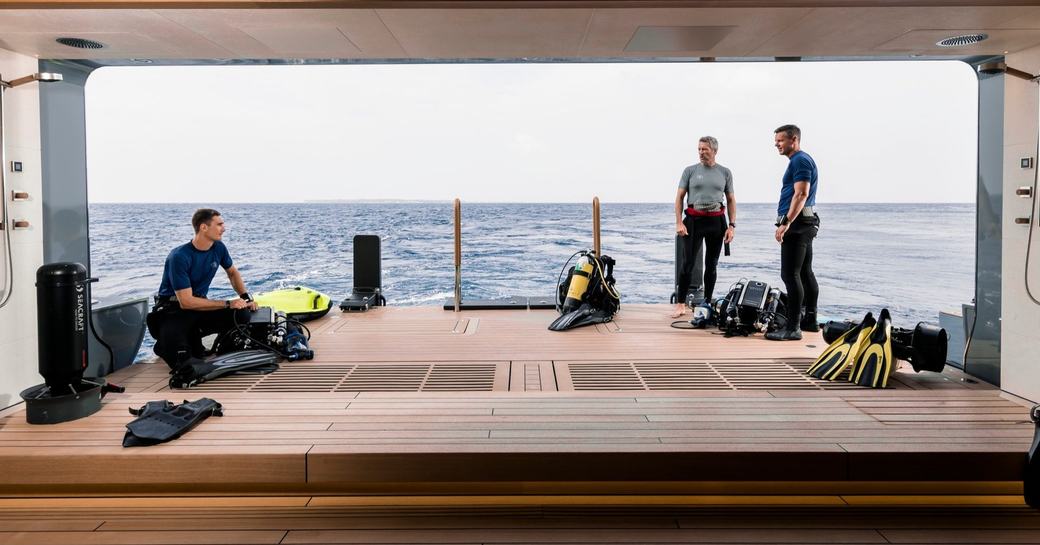
A Simple Guide To Scuba Diving Qualifications In Yachting
For a successful career in yachting industry scuba certification is clearly a nice thing to have, as compared to a core qualification that is a necessity. That said, Scuba Diving certifications (often Dive Master or Instructor) can provide an advantage in overall candidate profile, and particularly for certain positions on certain yachts.
A significant percentage of yachts have scuba diving capability, including compressors on board, and numerous sets of full equipment. It is often considered advantageous to have a couple of reasonably experienced divers on board to be able to free up or retrieve fouled anchors, conduct hull inspections, and free up tangled props or bow thrusters. Also, there is the issue of recovering lost valuables overboard whilst at anchor.

A small but growing number of yachts are registered as approved dive centres with either PADI or SSI, and a handful even have full technical diving capabilities and their own recompression chambers.
This article provides an overview to the process of getting scuba certified and some handy tips on choosing the right dive school or Instructor. We’ll also take a quick look at the next steps after becoming Open Water qualified plus some considerations regarding keeping your skills up to date.
I want to get my first qualification. How do I start?
There are a number of international training agencies, but in yachting you definitely want to opt for an international certification. For the most part, that means either PADI or SSI. SSI have made inroads into PADI’s traditional dominance of the market, and the training standards of the two have many similarities. The quality of training can vary dramatically from one dive centre to another, between destinations and also depending on time of the year and individual Instructor. It is definitely worth doing a prior research, particularly online reviews including TripAdvisor.
In Antibes, one of the yachting hubs of Europe, quality diving training is offered by Diamond Diving, whose trainer Alex Diamond, PADI Course Director (Instructor Trainer), has twenty years of experience teaching diving in the South of France.
If you’re not sure diving is for you (you need to want to be underwater!), rather than commit to the full course best would be to sign up for an introductory programme. With PADI, it is called Discover Scuba Diving. Typically done over a day, with one session in confined water (pool or beach) and one in open water (beach or boat), this gives a credit at the discretion of the Instructor towards the Scuba Diver or Open Water diver qualification.

The Open Water course has all of the theory catered for via a modern and interactive eLearning platform. There’s a surprising amount of information you need to understand to dive competently and safely. The eLearning account is usually included within a full course price. As with other purchases, it’ always best to be aware of certain pricing strategies and go for those dive schools that include everything within the quoted course price. This should include the eLearning account, certification costs, all dives and boat fees, tuition and equipment hire.
The optimal way to do the course is to complete the eLearning before starting any in-water training. You then undertake confined water training in the pool or off the beach and the four open water dives. A fantastic experience and a great introduction to the wonderful world of scuba diving! You’re now qualified to dive to a depth of 18 metres, typically in a dive centre, guided by a dive professional. With regular practice and a bit more experience you can dive with a buddy in conditions comparable or easier than those that you learnt in.
If time or budget is an issue, another option is to do the Scuba Diver course which is 2/3rd’s of the content of the Open Water course and qualifies to dive guided to a maximum depth of 12 metres.
Once I’ve got my Open Water, what's next?
Getting qualified as an Open Water Diver is just the start of a possibly very long journey of wonderful experience exploring the world’s oceans, gaining knowledge as a diver. Like many technical outdoor sports, diving needs to be practiced regularly to be done competently, safely, and with enjoyment! Skills tend to go rusty quickly, even with thorough training, and it’s important that those skills are sharp when evolving in an environment that is not our own. Even more so if you’re being asked to fulfil a role that normally would be left to an experienced diver. It’s thus highly recommended to do a skills refresher when you’ve been out of the water for a few months or longer.

It's a great idea to consolidate the experience of your Open Water course by doing some fun dives, but also by sampling some of the specialty courses that are available. These are themed courses with two, three of four dives, and associated knowledge development. The Peak Performance Buoyancy Specialty is particularly highly recommended; it consists of two dives, helping you fast-track the quality of your buoyancy control – which basically means getting you more comfortable and confident in the water more quickly. The great advantage is these courses credit towards the Advanced Open Water Diver qualification, so by doing the PPB Specialty, you’ve done 20% of the Advanced Course.
Once you’ve done, 15-20 dives definitely consider doing the Advanced Open Water and then the Rescue Diver after 30 or so dives.


Leave a comment